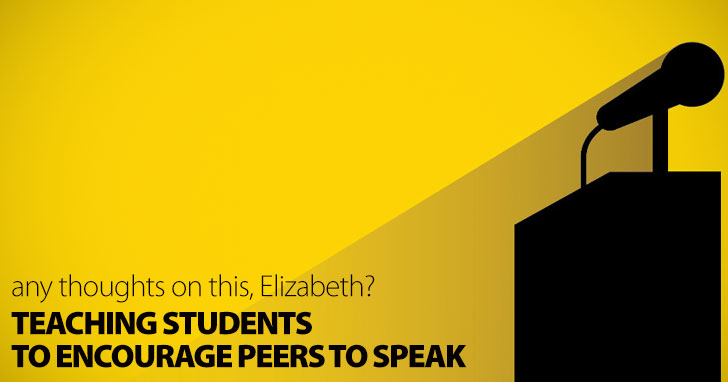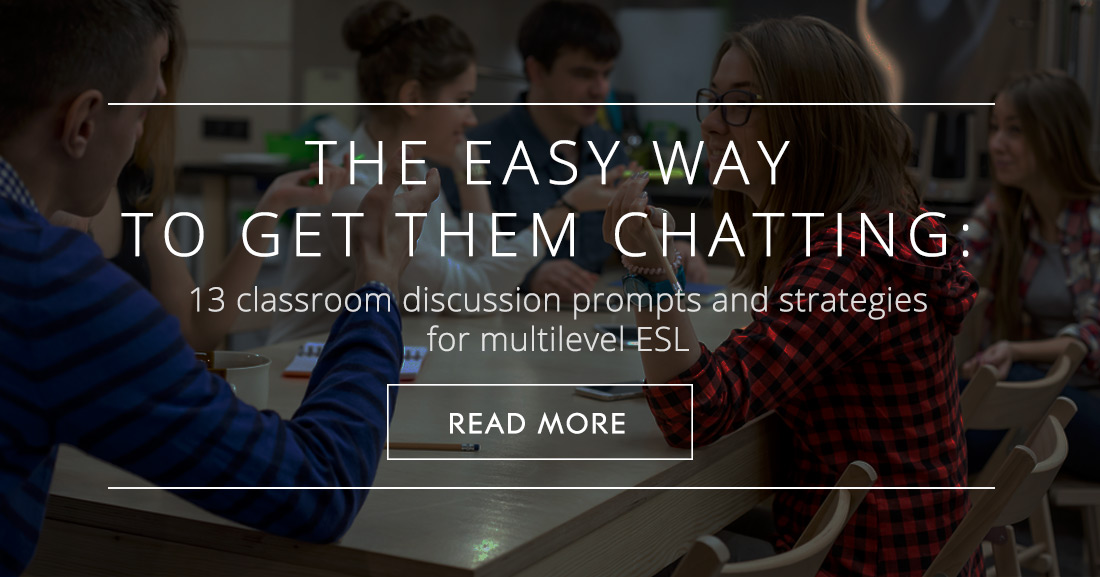Any Thoughts on This, Elizabeth? Teaching Students to Encourage Peers to Speak


These problems expand when the students are English language learners and at different levels of English skill. The natural impulse of the teacher may be to step in and turn the discussion into a lecture. However, there are a number of strategies the instructor can employ to get the class talking.
Most students will already know this, but a brief review before discussion about principles of academic discussion—listening courteously to others, sharing the floor, asking for other’s opinions as well as offering one’s own, and so forth, should be reviewed before the first class discussion and then just referred to as necessary as the semester proceeds.
If the topic is interesting yet general enough, everyone should be able to participate and will want to: changing family, study skills, cultural differences, etc. The more advanced students can take the lead while beginners can listen with some contributions.
Some students don’t talk because they don’t know how to enter a conversation, or extend it once they are in the conversation, nor how to close it. These skills can be taught. A list of phrases such as “I’d like to add something here—,” “What do you think about--?” and “Is there anything else?” and so forth with examples and taught with the correct pronunciation can develop students understanding of conversational strategies.
A basis for the discussion could be anything from a picture to a film clip to a longer reading. Even something like a picture of an office with people at work, for example, can lead to a conversation about jobs, types of jobs, changes in the workforce, comparisons between countries, that can go on for the entire class period.
If the group is too small, students may run out of things to say quickly; if it’s too big, it’s hard for the quieter students to compete with the more talkative ones. Four students comprise about the optimal group size. Balance the make up of the groups, as well. There should be a mix of beginners and more advanced students. If the group is all beginners, then there may be little discussion. One beginner should not be thrown in with a group of advanced more students, either.
If necessary, if the group is not talking, step in and prompt discussion, by asking one of the more advanced students his or her opinion. If the group is too raucous—unusual, but it does happen—intervene and remind about class policies, courtesy to the other groups and the group members, etc.
If the group is talking and engaged, no intervention is needed from the instructor. You may choice to sit in on discussions and listen, however.
A discussion facilitator or leader, one of the more advanced students, can help in promoting the discussion—prompting quiet students to participate and asking the more dominant ones to share the floor, and so forth. If the group is supposed to refer to a text in the discussion or produce some written product such as notes, the roles of “reader” and “writer” might be assigned as well. The roles should rotate throughout the term so that everyone gets practice at different roles within the group.
These are questions or points of discussion that can be given to the discussion leader. These should be designed with care: simple “yes” or “no” question should be avoided: “Was the reading too long?” as well as the simple informational questions: “Where did the story take place?” Rather, questions that prompt true thinking and interaction should be designed: “Why do you think the speech was successful?” “How did the author achieve a feeling of anxiety in the reader?” may prompt more thinking and discussion on the topic.
After reading an article or story, or viewing a video, etc., as homework, have the students come in with a short list of “discussion points.” They can then together decide which ones they want to cover in their groups.
At some point most or all of the groups will begin falling silent after a lively discussion. It is here that the topic is probably exhausted, and it is time to finish.
Review with the entire class some of the important issues you heard raised in the groups, common themes, comments you found interesting and surprising, that made you think, etc. Go over any final comments.
After a lively debate, have students in a page or so reflect on the experience: what they learned from the discussion, how they felt about it, how their perspective was changed or existing one validated, and so forth.
With some advance preparation and training, as well as attention to group dynamics, class discussions can be enjoyable and as well as a learning experience in both the course content and the strategies of discussion.